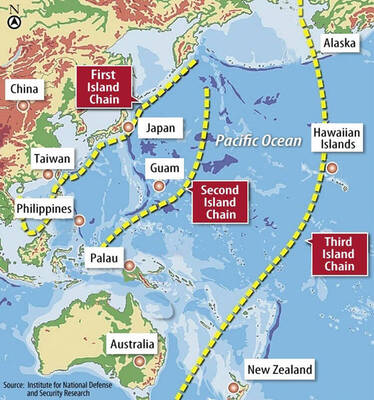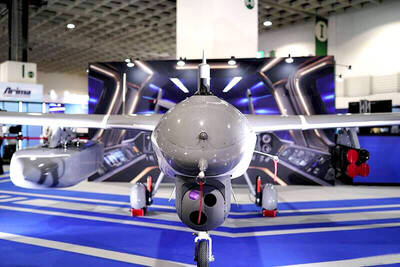A US congressional committee was told on Wednesday that Taiwan needed more advanced fighter aircraft and diesel submarines to defend itself against a possible attack by China.
Testifying before the US House of Representatives Committee on Foreign Affairs, Larry Wortzel, a specialist on the Chinese and Taiwanese military, said that despite a notable improvement in relations across the Taiwan Strait, Beijing continues to insist on its right to use force should Taiwan move toward independence.
“The cross-strait military balance increasingly favors China. Beijing has deployed over 1,100 short-range ballistic missiles opposite the island. In my view, Taiwan’s most pressing need is for new or modernized fighter aircraft,” Wortzel said.
Wortzel was speaking at a committee briefing on “China’s behavior and its impact on US interests” held on the first day of Chinese President Hu Jintao’s (胡錦濤) state visit to Washington.
Republican Representative David Rivera described Taiwan as “a bastion of democracy surrounded by a fortress of tyranny.”
NEW OR EXISTING
Wortzel said the big question was whether to sell Taipei F-16C/D aircraft, which have a long range and could be used for deep strikes inside China “if their [Taiwan’s] military chose to do that” or modernize the existing F-16A/B aircraft that Taiwan already possesses.
He said that he had talked with aviation engineers who thought that with the addition of brand new avionics, radar and targeting equipment, the A/Bs could be converted into “very capable aircraft.”
“They need the aircraft and I think they have to have that need addressed,” Wortzel said.
Representative Gerry Connolly, a Democrat, asked if there was any reason to believe that Taiwan was not capable of defending itself in case of an invasion.
“I don’t think that is the issue,” Wortzel said. “The issue is how capable would they be in doing it. They would have a hard time defending against 1,100 ballistic missiles. The missiles would do a lot of damage. They would be hard pressed if there were massive special operations insertions into Taiwan to disrupt the infrastructure.”
He said Taiwan could do more to strengthen airfields and storage facilities.
“If there is one thing they could do to immediately improve their capabilities, it would be to link all of their ground, naval, air assets and missiles so they could take part in cooperative target engagements,” Wortzel said. “They are developing their own multiple launch rocket systems and could probably use assistance with precision guided rounds.”
SUBMARINES
Asked about submarines, Wortzel said: “It’s a very difficult problem ... It’s a problem for the US Navy because we really don’t want to work on, or produce, diesel submarines, but they need these submarines.”
“The United States could get Costa Rica to buy a dozen submarines from Germany and then transfer them and it wouldn’t hurt anybody — if the Germans would look the other way on the re-transfer,” he said.

The US government has signed defense cooperation agreements with Japan and the Philippines to boost the deterrence capabilities of countries in the first island chain, a report by the National Security Bureau (NSB) showed. The main countries on the first island chain include the two nations and Taiwan. The bureau is to present the report at a meeting of the legislature’s Foreign Affairs and National Defense Committee tomorrow. The US military has deployed Typhon missile systems to Japan’s Yamaguchi Prefecture and Zambales province in the Philippines during their joint military exercises. It has also installed NMESIS anti-ship systems in Japan’s Okinawa

‘WIN-WIN’: The Philippines, and central and eastern European countries are important potential drone cooperation partners, Minister of Foreign Affairs Lin Chia-lung said Minister of Foreign Affairs Lin Chia-lung (林佳龍) in an interview published yesterday confirmed that there are joint ventures between Taiwan and Poland in the drone industry. Lin made the remark in an exclusive interview with the Chinese-language Liberty Times (the Taipei Times’ sister paper). The government-backed Taiwan Excellence Drone International Business Opportunities Alliance and the Polish Chamber of Unmanned Systems on Wednesday last week signed a memorandum of understanding in Poland to develop a “non-China” supply chain for drones and work together on key technologies. Asked if Taiwan prioritized Poland among central and eastern European countries in drone collaboration, Lin

BACK TO WORK? Prosecutors said they are considering filing an appeal, while the Hsinchu City Government said it has applied for Ann Kao’s reinstatement as mayor The High Court yesterday found suspended Hsinchu mayor Ann Kao (高虹安) not guilty of embezzling assistant fees, reducing her sentence to six months in prison commutable to a fine from seven years and four months. The verdict acquitted Kao of the corruption charge, but found her guilty of causing a public official to commit document forgery. The High Prosecutors’ Office said it is reviewing the ruling and considering whether to file an appeal. The Taipei District Court in July last year sentenced Kao to seven years and four months in prison, along with a four-year deprivation of civil rights, for contravening the Anti-Corruption

NO CONFIDENCE MOTION? The premier said that being toppled by the legislature for defending the Constitution would be a democratic badge of honor for him Premier Cho Jung-tai (卓榮泰) yesterday announced that the Cabinet would not countersign the amendments to the local revenue-sharing law passed by the Legislative Yuan last month. Cho said the decision not to countersign the amendments to the Act Governing the Allocation of Government Revenues and Expenditures (財政收支劃分法) was made in accordance with the Constitution. “The decision aims to safeguard our Constitution,” he said. The Constitution stipulates the president shall, in accordance with law, promulgate laws and issue mandates with the countersignature of the head of the Executive Yuan, or with the countersignatures of both the head of the Executive Yuan and ministers or